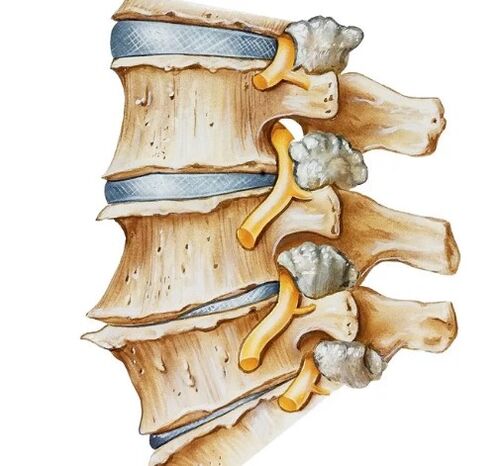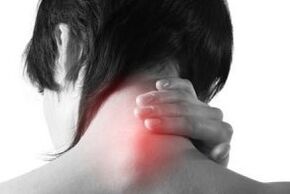-CircleSymptoms and treatment of cervical spine osteochondrosisThey differ depending on each other, depending on the type of deformation in the cervical vertebrae, which have a long physical, inflammatory or mental effect on them.
The disease is often chronic, which shows many clinical symptoms caused by tightening of nerve roots and blood vessels out of the vertebrae. Their compression is due to the abrasion or deformation of intervertebral discs (reducing their height, loss of elasticity, deformation of the fiber ring). Cervical osteochondrosis is a common disease that occurs at any age after 20 years.
The cause of the pathology is the devastating changes in the spine. Above all, changes in intervertebral discs occur: their elasticity, strength and height decrease, their fibrous ring are deformed, protrusions (initial stages of intervertebral hernia) and hernia appear. All of these changes trigger the bone growth of the vertebrae (osteophytes), leading to displacement and later - to the loss of cervical mobility. Because the spine is a flexible protective "case" for the spinal cord, destructive changes in intervertebral discs and loss of elasticity of the spinal cord for the nerve and vascular structure of the spinal cord. They should be subjected to tightening, displacement that disrupts the cerebral circulation and not only the cervix and shoulder zone, but also the internal organs, the lower limbs.
The older the patient, the more intervertebral discs have been changed by age -related muscle weakening, long load of spine, slowing down injuries, slowing up physical activity, inadequate posture, stressful situations and increased tension in the neck, shoulders, inflammatory diseases of the shoulders, etc.
Due to its anatomical structure, the cervical spine tends to pathology because the vertebrae are the most modern and very closely located. In addition, the cervical vertebrae have poor muscle protection. Most often, degenerative changes occur in the intervertebral plates of the most mobile vertebrae between 5. 6, 7 cervical vertebrae.
What are the symptoms of osteochondrosis of the cervix
The diversity and inconsistency of symptoms
Symptoms and treatment of cervical spine osteochondrosisThis should be considered comprehensively and with the type and severity of the degeneration of the intervertebral discs. The signs of osteochondrosis of the cervix are varied and contradictory, as they depend on the localization and strength of the deformation process of invertebrates, the specifics of compression or nerve roots and blood vessels, and the location of the muscles and organs.
Therefore, patient complaints are often directed to neurologist, but to other professionals: cardiologist, therapist, otolaryngolologist, optometrist, rheumatologist, etc. At the same time, a neuropathologist can diagnose the cervix osteochondrosis, the results of the brain MRI and the spine MRI, the ultrasound of the brain, etc.
Three signs of impaired function of the nervous system
Experienced professionals know thirty different options for the combination of cervical osteochondrosis symptoms. It is not possible to describe all signs of manifestations of this common illness, so let us liveThree complexesThe main symptoms that characterize certain damage to the central nervous system.
The first complex of basic symptoms refers to impaired functions of the peripheral phase of the nervous system. This class is represented by nerves and other elements that leave the brain and spinal cord and divide into somatic and autonomous systems.
In short, the first complex of symptoms of osteochondrosis of cervical osteochondrosis is shown in the form of different localization of pain. This does not mean that the signs are only painful, often combining pains with other damaged body functions. But first and foremost - they are constant or periodically painful in the neck, which is associated with patient hypothermia, for prolonged stress or unpleasant pose, lifting weights, and sharp turns of the head.
The pains hurt, shoot or similar to shock. Their localization depends on the tension of certain muscles to the specific roots of the nerves, which are squeezed by the vertebrae. Therefore, the pain can spread around the neck, the sun, the shoulder, one or both hands, radiates to the chest - the heart, the liver. In addition, there are crunching or crunching complaints in the vertebrae of the cervix when the head moves and the stiffness of the head rotation.
When the disease develops acute, the pain in the cervical muscles and cramps make the patient to be in a pose and the head leaned down and turns. Burning pains can appear between the shoulder blades if the vegetative formations of the cervix are compressed and their blood supply is confused. Such pains usually increase with physical and emotional stress.
Often there are swelling, pallor and cooling, numbness, rapid heartbeat, pain in the heart, narrowing or extending students, etc. Due to the innervation of the impaired shoulder and the spatular region, symptoms of dystrophic change in the shoulder joint may occur. Patients complain of pain, nonsense to lift and take to the side, and the stiffness of the shoulder joint.
The second complex of the symptoms of cervical osteochondrosis occurs due to impaired spinal function and is manifested by the engine disorders.
Disorders for spinal cord functions are due to compression because loss of pulpons from the plate or damage with solid discs and growth (osteophytes). Depending on the mechanism of exposure to the spinal cord, the following complex of motor disorders should be observed: the stiffness of the occult and the cervix muscles, the weakness of the arms and legs, the increased tone of the leg muscles, and the reduced tone and weight loss; Loss of temperature and pain sensitivity; The legs are severe fatigue, impaired coordination.
The third set of symptoms is characterized by blood supply disorders in the blood vessels and the pathology of the cervical nerves that occur due to deformation of cervical vertebrae. Symptoms of vascular pathology are reflected.
Typical symptoms of vascular disorders:
- neurotic conditions (irritability, desire, anxiety, fatigue, sleep disorders);
- faint; headache and dizziness; nausea and vomiting;
- noise and ringing in the ear, hearing loss;
- visual disorders (darkness, fog, flashing points, visual impairment);
- Glorious mining syndrome (sore throat, sensation of foreign object, dryness, difficulty swallowing).
The symptoms of the cervix osteochondrosis are unclear and should be taken into account in the complex and the abnormal processes of the spine.
Only one qualified professional can deal with the clinical manifestations of this disease, make the correct diagnosis and prescribe the proper treatment of the causes of the disorders detected.
How to treat this disease
Symptoms of the cervical spine and treatment osteochondrosis depend on the condition of the patient, the severity of the disease and the damage to the cervical vertebrae.
During the acute period, hospital care and drug treatment may be required. Usually uses painkillers, novocaine muscle block, muscle relaxes that alleviate muscle spasm; Chondroprotectors for cartilage nutrition; Soothing drugs that soothe the nervous system, vitamins B, improving neuromuscular conductivity. Treatment of osteochondrosis of the cervical spine should always be long and must be complex.
During the periods of remission, when acute symptoms are absent, physiotherapy methods (electrophoresis, ultrasound, etc. ) are widely used, therapeutic physical education, massage, and non -conventional procedures such as acupuncture are necessarily prescribed.
There are many conservative methods of treating osteochondrosis that can stop the progression of the disease. However, each patient needs individual treatment, taking into account the stage of the disease, the characteristics of the body, the gender and the age. The purpose of treating the cervix osteochondrosis is:
- Eliminating pain and edema at the site of inflammation.
- Resting the tense muscles of the neck.
- The release of the clamped nerve roots.
- Increased blood circulation.
- Activation of metabolism.
- Improving the power of intervertebral discs.
Targeted complex treatment may prevent the occurrence of protrus and intervertebral hernia.
In order to make the symptoms and treatment of osteochondrosis and treatment, and serious complications of the disease should be started on timely treatment.

























